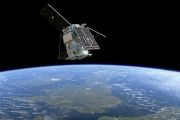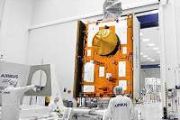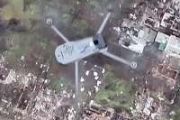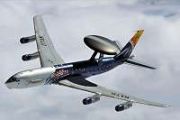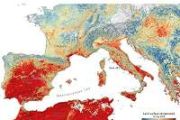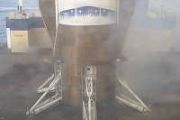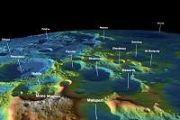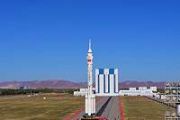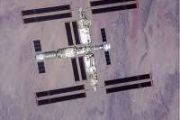
Copernical Team
New Beidou satellite launches into orbit
 China launched a Long March 3B carrier rocket on Wednesday morning to transport a satellite into space for the country's Beidou Navigation Satellite System, marking the first deployment of a Beidou satellite in three years.
As the countdown ticked down to zero at 10:49 am at the Xichang Satellite Launch Center in the southwestern mountainous region in Sichuan province, eight engines on the
China launched a Long March 3B carrier rocket on Wednesday morning to transport a satellite into space for the country's Beidou Navigation Satellite System, marking the first deployment of a Beidou satellite in three years.
As the countdown ticked down to zero at 10:49 am at the Xichang Satellite Launch Center in the southwestern mountainous region in Sichuan province, eight engines on the Sidus Space contracts with Leaf Space for additional ground station coverage
 Sidus Space Inc. (NASDAQ: SIDU), a pioneer in the Space and Defense-as-a-Service satellite sector with a keen focus on manufacturing mission-critical hardware, providing multi-disciplinary engineering services, satellite design, production, launch planning, mission operations and in-orbit support, has today expressed delight in announcing the signing of a pivotal service agreement with Leaf Spac
Sidus Space Inc. (NASDAQ: SIDU), a pioneer in the Space and Defense-as-a-Service satellite sector with a keen focus on manufacturing mission-critical hardware, providing multi-disciplinary engineering services, satellite design, production, launch planning, mission operations and in-orbit support, has today expressed delight in announcing the signing of a pivotal service agreement with Leaf Spac UAE partnerships boost commercial space opportunities
 Bayanat and Al Yah Satellite Communications have announced a comprehensive Space Program aimed at building national satellite remote sensing and Earth Observation (EO) capabilities within the UAE to commercially address business opportunities in the local and global EO market.
The program forms part of the two companies' partnership with ICEYE, a renowned SAR satellite manufacturer based i
Bayanat and Al Yah Satellite Communications have announced a comprehensive Space Program aimed at building national satellite remote sensing and Earth Observation (EO) capabilities within the UAE to commercially address business opportunities in the local and global EO market.
The program forms part of the two companies' partnership with ICEYE, a renowned SAR satellite manufacturer based i UK leads Europe in race for space investment, new report finds
 A PwC-UK Space Agency report reveals the UK is the most attractive destination for private investment in space after the US.
New analysis from investment experts offers insight on the wealth of opportunities found within the UK's 17.5 billion pounds space sector.
The 'Expanding frontiers - The down to earth guide to investing in space' report, produced by PwC in association with the
A PwC-UK Space Agency report reveals the UK is the most attractive destination for private investment in space after the US.
New analysis from investment experts offers insight on the wealth of opportunities found within the UK's 17.5 billion pounds space sector.
The 'Expanding frontiers - The down to earth guide to investing in space' report, produced by PwC in association with the Radio signal reveals supernova origin
 In the latest issue of the journal Nature, astronomers from Stockholm University reveal the origin of a thermonuclear supernova explosion. Strong emission lines of helium and the first detection of such a supernova in radio waves show that the exploding white dwarf star had a helium-rich companion.
Supernovae of Type Ia are important for astronomers since they are used to measure the expan
In the latest issue of the journal Nature, astronomers from Stockholm University reveal the origin of a thermonuclear supernova explosion. Strong emission lines of helium and the first detection of such a supernova in radio waves show that the exploding white dwarf star had a helium-rich companion.
Supernovae of Type Ia are important for astronomers since they are used to measure the expan Curved spacetime in a quantum simulator
 The theory of relativity works well when you want to explain cosmic-scale phenomena - such as the gravitational waves created when black holes collide. Quantum theory works well when describing particle-scale phenomena - such as the behavior of individual electrons in an atom. But combining the two in a completely satisfactory way has yet to be achieved. The search for a "quantum theory of gravi
The theory of relativity works well when you want to explain cosmic-scale phenomena - such as the gravitational waves created when black holes collide. Quantum theory works well when describing particle-scale phenomena - such as the behavior of individual electrons in an atom. But combining the two in a completely satisfactory way has yet to be achieved. The search for a "quantum theory of gravi NASA's Spitzer, TESS find potentially volcano-covered Earth-size world
 Astronomers have discovered an Earth-size exoplanet, or world beyond our solar system, that may be carpeted with volcanoes. Called LP 791-18 d, the planet could undergo volcanic outbursts as often as Jupiter's moon Io, the most volcanically active body in our solar system.
They found and studied the planet using data from NASA's TESS (Transiting Exoplanet Survey Satellite) and retired Spit
Astronomers have discovered an Earth-size exoplanet, or world beyond our solar system, that may be carpeted with volcanoes. Called LP 791-18 d, the planet could undergo volcanic outbursts as often as Jupiter's moon Io, the most volcanically active body in our solar system.
They found and studied the planet using data from NASA's TESS (Transiting Exoplanet Survey Satellite) and retired Spit Martian crust like heavy armour
 A strong quake in the last year of the NASA Mars InSight mission, enabled researchers at ETH Zurich to determine the global thickness and density of the planet's crust. On average, the Martian crust is much thicker than the Earth's or the Moon's crust, and the planet's main source of heat is radioactive.
In May 2022, the Marsquake Service at ETH Zurich recorded the largest quake ever obser
A strong quake in the last year of the NASA Mars InSight mission, enabled researchers at ETH Zurich to determine the global thickness and density of the planet's crust. On average, the Martian crust is much thicker than the Earth's or the Moon's crust, and the planet's main source of heat is radioactive.
In May 2022, the Marsquake Service at ETH Zurich recorded the largest quake ever obser What's so special about large grains on Mars
 The Perseverance rover has been exploring the top of the Western fan in Jezero crater for some time now, but new observations never fail to offer new insights. Sitting at the edge of Belva crater on top of the fan, Perseverance has been investigating sediments that were transported to their location via the ancient streams that flowed into Jezero.
Each unique rock, boulder, or sediment tha
The Perseverance rover has been exploring the top of the Western fan in Jezero crater for some time now, but new observations never fail to offer new insights. Sitting at the edge of Belva crater on top of the fan, Perseverance has been investigating sediments that were transported to their location via the ancient streams that flowed into Jezero.
Each unique rock, boulder, or sediment tha Smaller, lighter space-based imaging spectrometers with high spectral resolution
 Researchers have developed a new smaller, lighter design for space-based imaging spectrometers with high spectral resolution. These high-dispersion imaging spectrometers could be used onboard spacecraft or satellites to study the Earth's atmosphere or the atmospheres of other planets.
James P. McGuire, Jr. from NASA's Jet Propulsion Laboratory in Southern California will present the new re
Researchers have developed a new smaller, lighter design for space-based imaging spectrometers with high spectral resolution. These high-dispersion imaging spectrometers could be used onboard spacecraft or satellites to study the Earth's atmosphere or the atmospheres of other planets.
James P. McGuire, Jr. from NASA's Jet Propulsion Laboratory in Southern California will present the new re 








